2007 CHEVROLET HHR clutch
[x] Cancel search: clutchPage 119 of 446
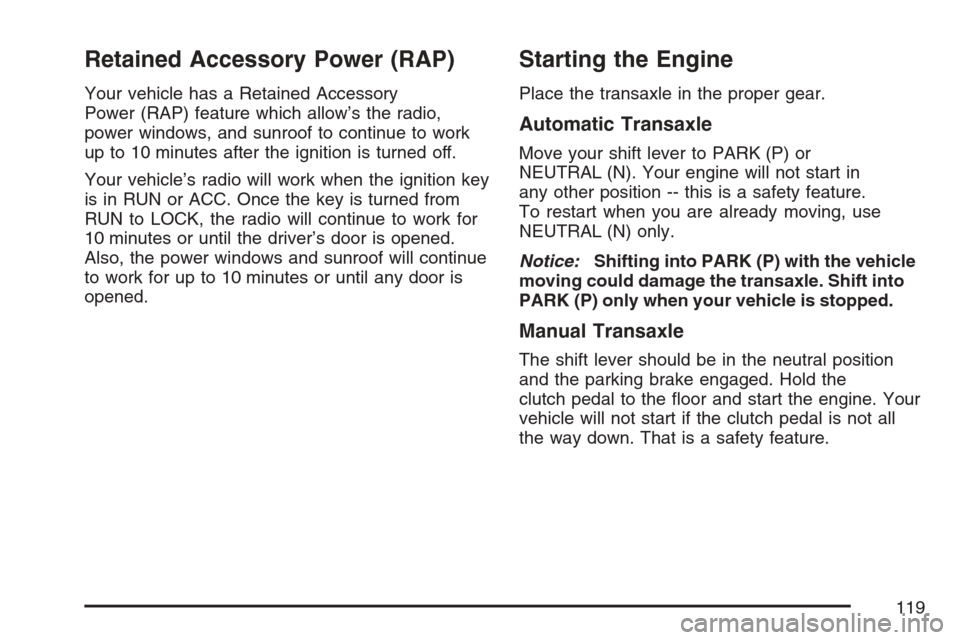
Retained Accessory Power (RAP)
Your vehicle has a Retained Accessory
Power (RAP) feature which allow’s the radio,
power windows, and sunroof to continue to work
up to 10 minutes after the ignition is turned off.
Your vehicle’s radio will work when the ignition key
is in RUN or ACC. Once the key is turned from
RUN to LOCK, the radio will continue to work for
10 minutes or until the driver’s door is opened.
Also, the power windows and sunroof will continue
to work for up to 10 minutes or until any door is
opened.
Starting the Engine
Place the transaxle in the proper gear.
Automatic Transaxle
Move your shift lever to PARK (P) or
NEUTRAL (N). Your engine will not start in
any other position -- this is a safety feature.
To restart when you are already moving, use
NEUTRAL (N) only.
Notice:Shifting into PARK (P) with the vehicle
moving could damage the transaxle. Shift into
PARK (P) only when your vehicle is stopped.
Manual Transaxle
The shift lever should be in the neutral position
and the parking brake engaged. Hold the
clutch pedal to the �oor and start the engine. Your
vehicle will not start if the clutch pedal is not all
the way down. That is a safety feature.
119
Page 125 of 446
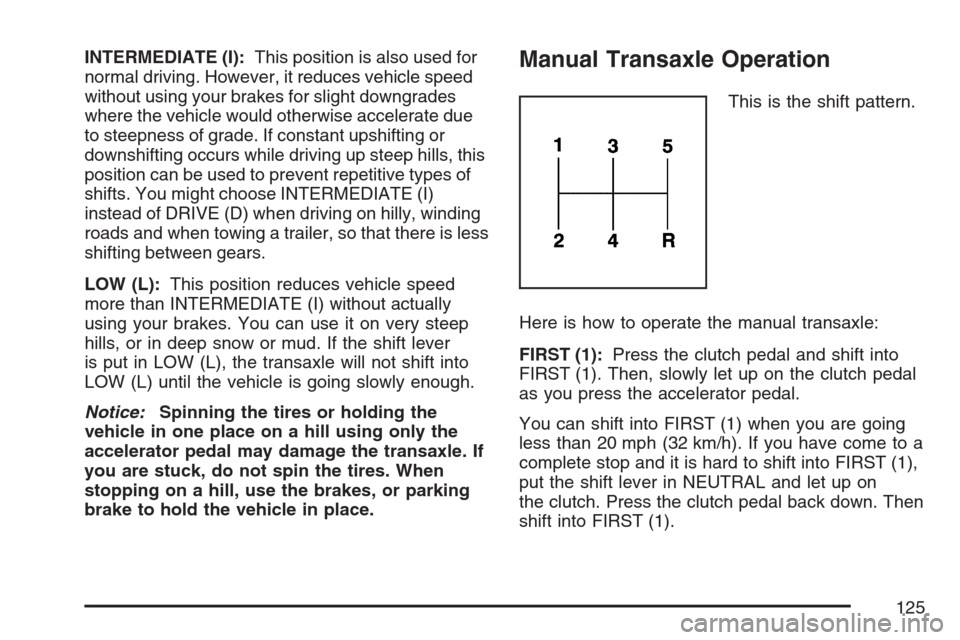
INTERMEDIATE (I):This position is also used for
normal driving. However, it reduces vehicle speed
without using your brakes for slight downgrades
where the vehicle would otherwise accelerate due
to steepness of grade. If constant upshifting or
downshifting occurs while driving up steep hills, this
position can be used to prevent repetitive types of
shifts. You might choose INTERMEDIATE (I)
instead of DRIVE (D) when driving on hilly, winding
roads and when towing a trailer, so that there is less
shifting between gears.
LOW (L):This position reduces vehicle speed
more than INTERMEDIATE (I) without actually
using your brakes. You can use it on very steep
hills, or in deep snow or mud. If the shift lever
is put in LOW (L), the transaxle will not shift into
LOW (L) until the vehicle is going slowly enough.
Notice:Spinning the tires or holding the
vehicle in one place on a hill using only the
accelerator pedal may damage the transaxle. If
you are stuck, do not spin the tires. When
stopping on a hill, use the brakes, or parking
brake to hold the vehicle in place.Manual Transaxle Operation
This is the shift pattern.
Here is how to operate the manual transaxle:
FIRST (1):Press the clutch pedal and shift into
FIRST (1). Then, slowly let up on the clutch pedal
as you press the accelerator pedal.
You can shift into FIRST (1) when you are going
less than 20 mph (32 km/h). If you have come to a
complete stop and it is hard to shift into FIRST (1),
put the shift lever in NEUTRAL and let up on
the clutch. Press the clutch pedal back down. Then
shift into FIRST (1).
125
Page 126 of 446
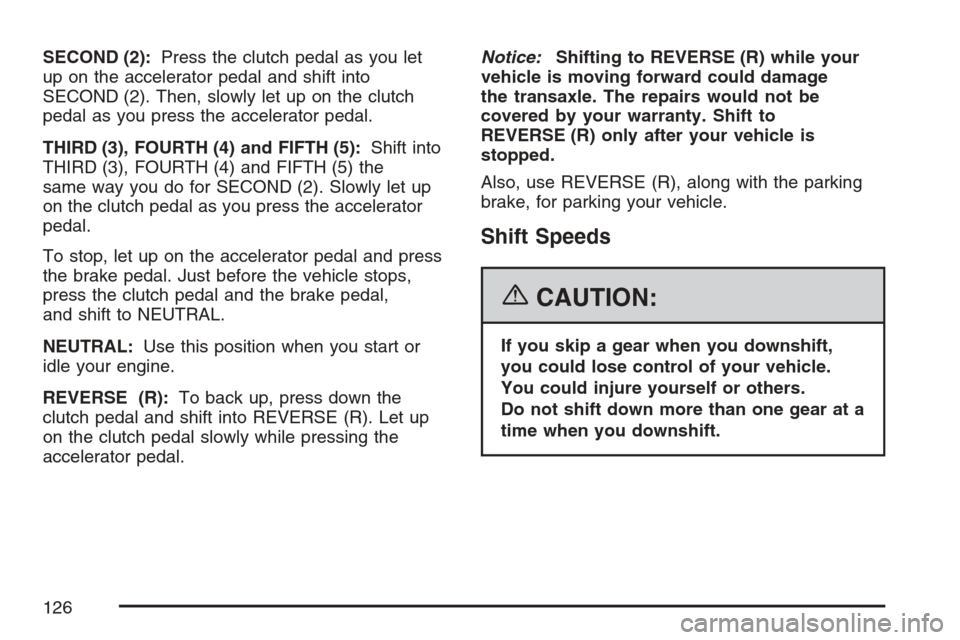
SECOND (2):Press the clutch pedal as you let
up on the accelerator pedal and shift into
SECOND (2). Then, slowly let up on the clutch
pedal as you press the accelerator pedal.
THIRD (3), FOURTH (4) and FIFTH (5):Shift into
THIRD (3), FOURTH (4) and FIFTH (5) the
same way you do for SECOND (2). Slowly let up
on the clutch pedal as you press the accelerator
pedal.
To stop, let up on the accelerator pedal and press
the brake pedal. Just before the vehicle stops,
press the clutch pedal and the brake pedal,
and shift to NEUTRAL.
NEUTRAL:Use this position when you start or
idle your engine.
REVERSE (R):To back up, press down the
clutch pedal and shift into REVERSE (R). Let up
on the clutch pedal slowly while pressing the
accelerator pedal.Notice:Shifting to REVERSE (R) while your
vehicle is moving forward could damage
the transaxle. The repairs would not be
covered by your warranty. Shift to
REVERSE (R) only after your vehicle is
stopped.
Also, use REVERSE (R), along with the parking
brake, for parking your vehicle.
Shift Speeds
{CAUTION:
If you skip a gear when you downshift,
you could lose control of your vehicle.
You could injure yourself or others.
Do not shift down more than one gear at a
time when you downshift.
126
Page 130 of 446
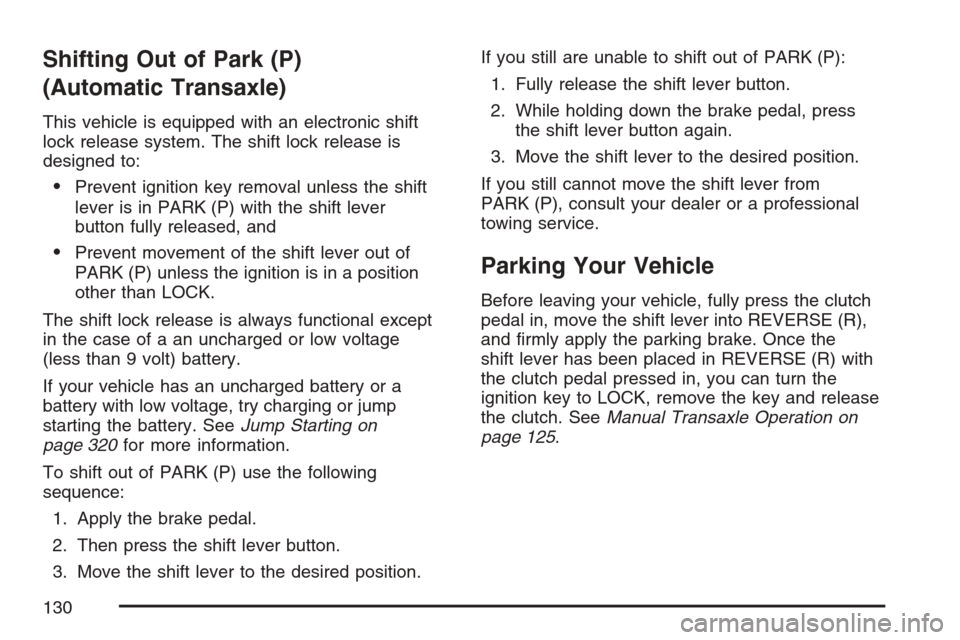
Shifting Out of Park (P)
(Automatic Transaxle)
This vehicle is equipped with an electronic shift
lock release system. The shift lock release is
designed to:
Prevent ignition key removal unless the shift
lever is in PARK (P) with the shift lever
button fully released, and
Prevent movement of the shift lever out of
PARK (P) unless the ignition is in a position
other than LOCK.
The shift lock release is always functional except
in the case of a an uncharged or low voltage
(less than 9 volt) battery.
If your vehicle has an uncharged battery or a
battery with low voltage, try charging or jump
starting the battery. SeeJump Starting on
page 320for more information.
To shift out of PARK (P) use the following
sequence:
1. Apply the brake pedal.
2. Then press the shift lever button.
3. Move the shift lever to the desired position.If you still are unable to shift out of PARK (P):
1. Fully release the shift lever button.
2. While holding down the brake pedal, press
the shift lever button again.
3. Move the shift lever to the desired position.
If you still cannot move the shift lever from
PARK (P), consult your dealer or a professional
towing service.Parking Your Vehicle
Before leaving your vehicle, fully press the clutch
pedal in, move the shift lever into REVERSE (R),
and �rmly apply the parking brake. Once the
shift lever has been placed in REVERSE (R) with
the clutch pedal pressed in, you can turn the
ignition key to LOCK, remove the key and release
the clutch. SeeManual Transaxle Operation on
page 125.
130
Page 161 of 446
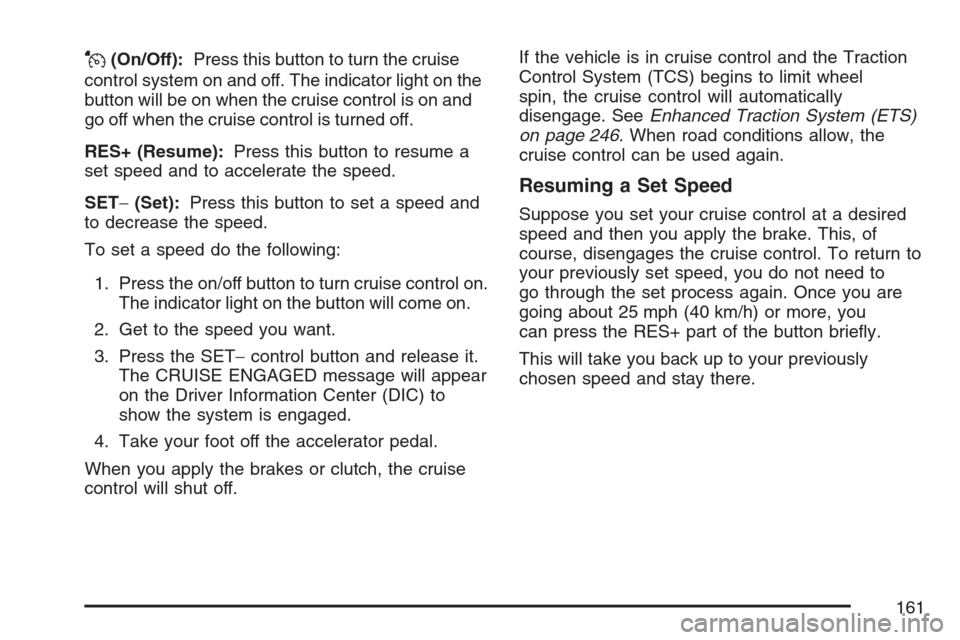
J(On/Off):Press this button to turn the cruise
control system on and off. The indicator light on the
button will be on when the cruise control is on and
go off when the cruise control is turned off.
RES+ (Resume):Press this button to resume a
set speed and to accelerate the speed.
SET−(Set):Press this button to set a speed and
to decrease the speed.
To set a speed do the following:
1. Press the on/off button to turn cruise control on.
The indicator light on the button will come on.
2. Get to the speed you want.
3. Press the SET−control button and release it.
The CRUISE ENGAGED message will appear
on the Driver Information Center (DIC) to
show the system is engaged.
4. Take your foot off the accelerator pedal.
When you apply the brakes or clutch, the cruise
control will shut off.If the vehicle is in cruise control and the Traction
Control System (TCS) begins to limit wheel
spin, the cruise control will automatically
disengage. SeeEnhanced Traction System (ETS)
on page 246. When road conditions allow, the
cruise control can be used again.
Resuming a Set Speed
Suppose you set your cruise control at a desired
speed and then you apply the brake. This, of
course, disengages the cruise control. To return to
your previously set speed, you do not need to
go through the set process again. Once you are
going about 25 mph (40 km/h) or more, you
can press the RES+ part of the button brie�y.
This will take you back up to your previously
chosen speed and stay there.
161
Page 162 of 446
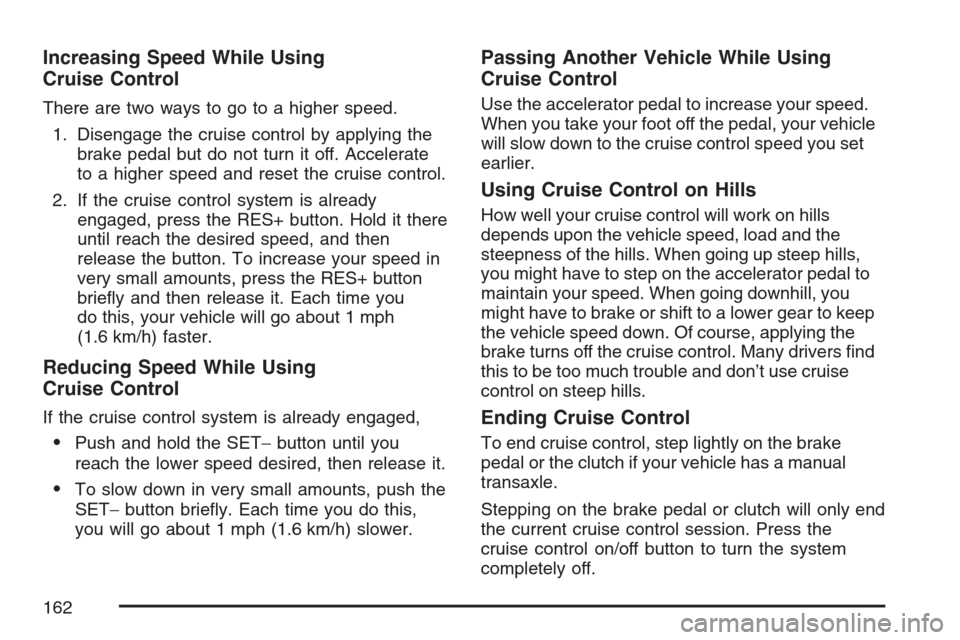
Increasing Speed While Using
Cruise Control
There are two ways to go to a higher speed.
1. Disengage the cruise control by applying the
brake pedal but do not turn it off. Accelerate
to a higher speed and reset the cruise control.
2. If the cruise control system is already
engaged, press the RES+ button. Hold it there
until reach the desired speed, and then
release the button. To increase your speed in
very small amounts, press the RES+ button
brie�y and then release it. Each time you
do this, your vehicle will go about 1 mph
(1.6 km/h) faster.
Reducing Speed While Using
Cruise Control
If the cruise control system is already engaged,
Push and hold the SET−button until you
reach the lower speed desired, then release it.
To slow down in very small amounts, push the
SET−button brie�y. Each time you do this,
you will go about 1 mph (1.6 km/h) slower.
Passing Another Vehicle While Using
Cruise Control
Use the accelerator pedal to increase your speed.
When you take your foot off the pedal, your vehicle
will slow down to the cruise control speed you set
earlier.
Using Cruise Control on Hills
How well your cruise control will work on hills
depends upon the vehicle speed, load and the
steepness of the hills. When going up steep hills,
you might have to step on the accelerator pedal to
maintain your speed. When going downhill, you
might have to brake or shift to a lower gear to keep
the vehicle speed down. Of course, applying the
brake turns off the cruise control. Many drivers �nd
this to be too much trouble and don’t use cruise
control on steep hills.
Ending Cruise Control
To end cruise control, step lightly on the brake
pedal or the clutch if your vehicle has a manual
transaxle.
Stepping on the brake pedal or clutch will only end
the current cruise control session. Press the
cruise control on/off button to turn the system
completely off.
162
Page 287 of 446
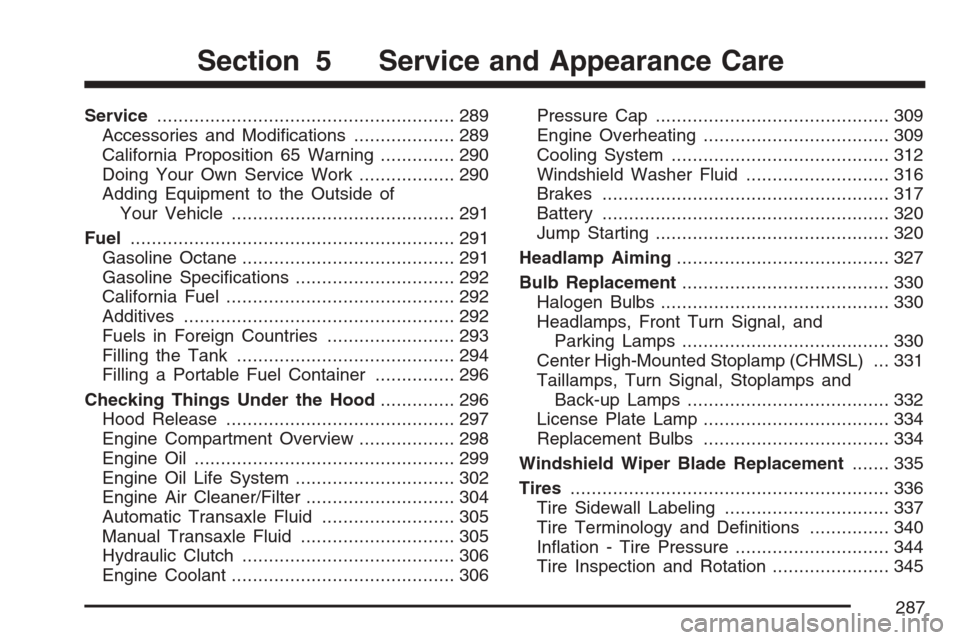
Service........................................................ 289
Accessories and Modi�cations................... 289
California Proposition 65 Warning.............. 290
Doing Your Own Service Work.................. 290
Adding Equipment to the Outside of
Your Vehicle.......................................... 291
Fuel............................................................. 291
Gasoline Octane........................................ 291
Gasoline Speci�cations.............................. 292
California Fuel........................................... 292
Additives................................................... 292
Fuels in Foreign Countries........................ 293
Filling the Tank......................................... 294
Filling a Portable Fuel Container............... 296
Checking Things Under the Hood.............. 296
Hood Release........................................... 297
Engine Compartment Overview.................. 298
Engine Oil................................................. 299
Engine Oil Life System.............................. 302
Engine Air Cleaner/Filter............................ 304
Automatic Transaxle Fluid......................... 305
Manual Transaxle Fluid............................. 305
Hydraulic Clutch........................................ 306
Engine Coolant.......................................... 306Pressure Cap............................................ 309
Engine Overheating................................... 309
Cooling System......................................... 312
Windshield Washer Fluid........................... 316
Brakes...................................................... 317
Battery...................................................... 320
Jump Starting............................................ 320
Headlamp Aiming........................................ 327
Bulb Replacement....................................... 330
Halogen Bulbs........................................... 330
Headlamps, Front Turn Signal, and
Parking Lamps....................................... 330
Center High-Mounted Stoplamp (CHMSL) ... 331
Taillamps, Turn Signal, Stoplamps and
Back-up Lamps...................................... 332
License Plate Lamp................................... 334
Replacement Bulbs................................... 334
Windshield Wiper Blade Replacement....... 335
Tires............................................................ 336
Tire Sidewall Labeling............................... 337
Tire Terminology and De�nitions............... 340
In�ation - Tire Pressure............................. 344
Tire Inspection and Rotation...................... 345
Section 5 Service and Appearance Care
287
Page 299 of 446
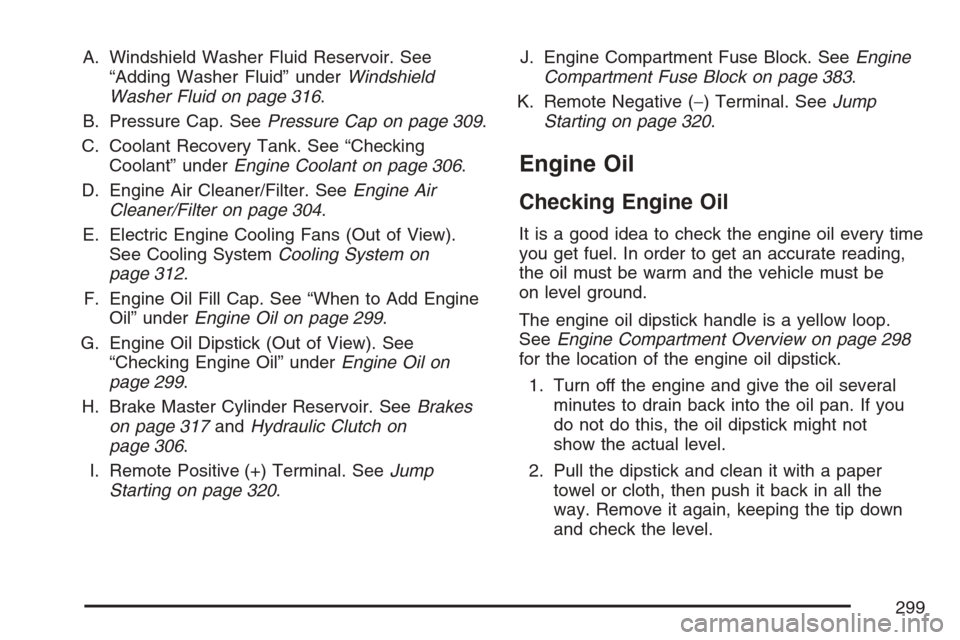
A. Windshield Washer Fluid Reservoir. See
“Adding Washer Fluid” underWindshield
Washer Fluid on page 316.
B. Pressure Cap. SeePressure Cap on page 309.
C. Coolant Recovery Tank. See “Checking
Coolant” underEngine Coolant on page 306.
D. Engine Air Cleaner/Filter. SeeEngine Air
Cleaner/Filter on page 304.
E. Electric Engine Cooling Fans (Out of View).
See Cooling SystemCooling System on
page 312.
F. Engine Oil Fill Cap. See “When to Add Engine
Oil” underEngine Oil on page 299.
G. Engine Oil Dipstick (Out of View). See
“Checking Engine Oil” underEngine Oil on
page 299.
H. Brake Master Cylinder Reservoir. SeeBrakes
on page 317andHydraulic Clutch on
page 306.
I. Remote Positive (+) Terminal. SeeJump
Starting on page 320.J. Engine Compartment Fuse Block. SeeEngine
Compartment Fuse Block on page 383.
K. Remote Negative (−) Terminal. SeeJump
Starting on page 320.
Engine Oil
Checking Engine Oil
It is a good idea to check the engine oil every time
you get fuel. In order to get an accurate reading,
the oil must be warm and the vehicle must be
on level ground.
The engine oil dipstick handle is a yellow loop.
SeeEngine Compartment Overview on page 298
for the location of the engine oil dipstick.
1. Turn off the engine and give the oil several
minutes to drain back into the oil pan. If you
do not do this, the oil dipstick might not
show the actual level.
2. Pull the dipstick and clean it with a paper
towel or cloth, then push it back in all the
way. Remove it again, keeping the tip down
and check the level.
299